
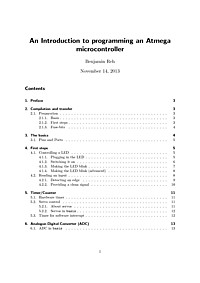
An Introduction to programming an Atmega microcontroller
This document an introduction into the programming of an Atmega microcontroller. It is separated into the fi rst part guiding like a tutorial for beginners and a second part which is a reference book to the functions provided in the basis. The examples and explanations provided are neither exhaustive nor complete. The only aim of this document is to lower the burden of getting started. Only a basic knowledge in C is required.
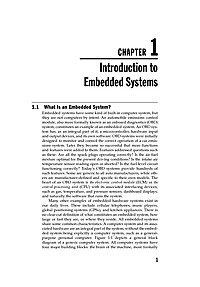
Introduction to Embedded Systems
This is the first chapter in the book Embedded Systems Hardware for Software Engineers.
Debugging Serial Buses in Embedded System Designs
Many embedded system designs utilize serial buses such as I2C, SPI , USB, RS-232/422/485/UART, CAN, LIN, FlexRay and I2S/LJ/RJ/TDM. Learn how to quickly and efficiently debug today’s serial buses with the powerful trigger, decode, and search capabilities of the MSO/DPO Series.

Design and Implementation of the lwIP Stack
LwIP is an implementation of the TCP/IP protocol stack. The focus of the lwIP stack is to reduce memory usage and code size, making lwIP suitable for use in small clients with very limited resources such as embedded systems. In order to reduce processing and memory demands, lwIP uses a tailor made API that does not require any data copying. This report describes the design and implementation of lwIP. The algorithms and data struc- tures used both in the protocol implementations and in the sub systems such as the memory and bu®er management systems are described. Also included in this report is a reference manual for the lwIP API and some code examples of using lwIP.
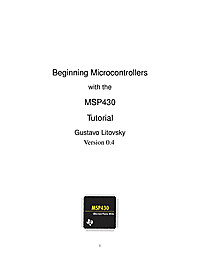
Beginning Microcontrollers with the MSP430 - Tutorial
From the Preface: I decided to write this tutorial after seeing many students struggling with the concepts of programming the MSP430 and being unable to realize their applications and projects. This was not because the MSP430 is hard to program. On the contrary, it adopts many advances in computing that has allowed us to get our application running quicker than ever. However, it is sometimes difficult for students to translate the knowledge they acquired when studying programming for more traditional platforms to embedded systems.
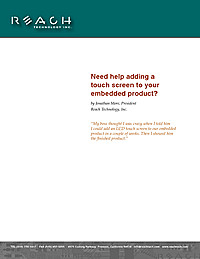
Embedded Touchscreen Handbook
I want to add a touchscreen to my embedded product. Where do I start? That question is common nowadays. Most manufacturing companies are seeing the value – maybe the necessity – of touch screen technology. Many of them don’t have a long-term or close association with the technology, yet they expect their embedded engineers to handle the project successfully and on a tight schedule. These engineers often have questions... - How much am I going to have to learn to get the job done? - I’ve heard that LCD suppliers were not like other suppliers. But, how so? - What don’t I know that could shift the project from “exciting” to “doomed.” You have choices: Probably the three major questions that crop up when you need to add an LCD touch screen to your product are these: - Should I use a full-blown, embedded operating system, like Windows CE, CE Linux or QNX? - How much work does it take to develop an in-house LCD system from scratch? - Do I have other options? The answer to the first two questions is a resounding “maybe,” (depending on what you need to accomplish). The answer to the third question is, probably “yes.” In most cases, there is another option. Who should read this? If you are an embedded engineer who is thinking of adding a touch screen to your product, and if: - You need to know what is involved in adding color touch controls to your product. -You need to understand the risks (both known and hidden) involved in LCD technology. - Your main area of expertise is not LCD technology. - You don’t want to re-focus your time to acquire color LCD technology expertise. If you find that any of the statements above voice your concerns, you may find this paper worth reading.

Interrupt handling in an ARM processor
This document is going to guide you at every step as you sit down to design the interrupt handling in software for an ARM system.
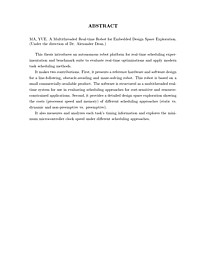
A Multithreaded Real-time Robot for Embedded Design Space Exploration
This thesis introduces an autonomous robot platform for real-time scheduling exper- imentation and benchmark suite to evaluate real-time optimizations and apply modern task scheduling methods. It makes two contributions. First, it presents a reference hardware and software design for a line-following, obstacle-avoiding and maze-solving robot. This robot is based on a small commercially-available product. The software is structured as a multithreaded real- time system for use in evaluating scheduling approaches for cost-sensitive and resource- constrained applications. Second, it provides a detailed design space exploration showing the costs (processor speed and memory) of di erent scheduling approaches (static vs. dynamic and non-preemptive vs. preemptive). It also measures and analyzes each task's timing information and explores the mini- mum microcontroller clock speed under di erent scheduling approaches.
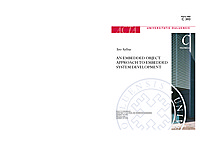
An Embedded Object Approach to Embedded System Development
Building an embedded system from an idea to a product is a slow and expensive process requiring a lot of expertise. Depending on the developer’s expertise, the required quantity and price level of the final product, and the time and money available for development, the developer can build a device from different granularity of components, ranging from ready-made platforms, kits, and modules to individual components. Generally, solutions requiring less expertise, time and money produce products with higher production costs. The main contribution of this thesis is the EOC (Embedded Object Concept) and Atomi II Framework. EOC utilizes common object-oriented methods used in software by applying them to small electronic modules, which create complete functional entities. The conceptual idea of the embedded objects is implemented with the Atomi II framework, which contains several techniques for making the EOC a commercially feasible implementation. The EOC and the Atomi II Framework decreases the difficulty level of making embedded systems by enabling a use of ready-made modules to build systems. It enables automatic conversion of a device made from such modules into an integrated PCB, lowering production costs compared to other modular approaches. Furthermore, it also enables an automatic production tester generation due to its modularity. These properties lower the number of skills required for building an embedded system and quicken the path from an idea to a commercially applicable device. A developer can also build custom modules of his own if he possesses the required expertise. The test cases demonstrate the Atomi II Framework techniques in real world applications, and demonstrate the capabilities of Atomi objects. According to our test cases and estimations, an Atomi based device becomes approximately 10% more expensive than a device built from individual components, but saves up to 50% time, making it feasible to manufacture up to 10-50k quantities with this approach.

Topics in Secure Embedded System Design
Pervasive networks have led to widespread use of embedded systems, like cell phones, PDAs, RFIDs etc., in increasingly diverse applications. Many of these embedded system appli- cations handle sensitive data (e.g., credit card information on a mobile phone/PDA) or perform critical functions (e.g., medical devices or automotive electronics), and the use of security protocols is imperative to maintain con dentiality, integrity and authentication of these applications. Typically embedded systems have low computing power and nite energy supply based on a battery, and these factors are at odds with the computationally intensive nature of the cryptographic algorithms underlying many security protocols. In addition, secure embedded systems are vulnerable to attacks, like physical tampering, malware and side-channel attacks. Thus, design of secure embedded systems is guided by the following factors: small form factor, good performance, low energy consumption (and, thus,longer battery life), and robustness to attacks. This thesis presents our work on tackling three issues in the design of secure embedded systems: energy consumption, performance and robustness to side-channel attacks. First, we present our work on optimizing the energy consumption of the widely employed secure sockets layer (SSL) protocol running on an embedded system. We discuss results of energy analysis of various cryptographic algorithms, and the manner in which this information can be used to adapt the operation of SSL protocol to save energy. Next, we present results of our experiments on optimizing the performance of Internet protocol security (IPSec) protocol on an embedded processor. Depending on the mode of operation, the IPSec computation is dominated by cryptographic or non-cryptographic processing. We demonstrate how both these components of the IPSec protocol can be optimized by leveraging the extensible and con gurable features of an embedded processor. Next, we introduce a satisfability-based framework for enabling side-channel attacks on cryptographic software running on an embedded processor. This framework enables us to identify variables in the software implementations which result in the disclosure of the secret key used. Thus, security of software implementations can be improved by better protection of these identified variables. Finally, we conclude by introducing a novel memory integrity checking protocol that has much lower communication complexity than existing Merkle tree-based protocols while incurring a modest price in computation on the processor. This scheme is based on Toeplitz matrices, and can be very efficiently realized on embedded systems with hardware extensions for bit matrix operations.

A Multithreaded Real-time Robot for Embedded Design Space Exploration
This thesis introduces an autonomous robot platform for real-time scheduling exper- imentation and benchmark suite to evaluate real-time optimizations and apply modern task scheduling methods. It makes two contributions. First, it presents a reference hardware and software design for a line-following, obstacle-avoiding and maze-solving robot. This robot is based on a small commercially-available product. The software is structured as a multithreaded real- time system for use in evaluating scheduling approaches for cost-sensitive and resource- constrained applications. Second, it provides a detailed design space exploration showing the costs (processor speed and memory) of di erent scheduling approaches (static vs. dynamic and non-preemptive vs. preemptive). It also measures and analyzes each task's timing information and explores the mini- mum microcontroller clock speed under di erent scheduling approaches.

An Embedded Object Approach to Embedded System Development
Building an embedded system from an idea to a product is a slow and expensive process requiring a lot of expertise. Depending on the developer’s expertise, the required quantity and price level of the final product, and the time and money available for development, the developer can build a device from different granularity of components, ranging from ready-made platforms, kits, and modules to individual components. Generally, solutions requiring less expertise, time and money produce products with higher production costs. The main contribution of this thesis is the EOC (Embedded Object Concept) and Atomi II Framework. EOC utilizes common object-oriented methods used in software by applying them to small electronic modules, which create complete functional entities. The conceptual idea of the embedded objects is implemented with the Atomi II framework, which contains several techniques for making the EOC a commercially feasible implementation. The EOC and the Atomi II Framework decreases the difficulty level of making embedded systems by enabling a use of ready-made modules to build systems. It enables automatic conversion of a device made from such modules into an integrated PCB, lowering production costs compared to other modular approaches. Furthermore, it also enables an automatic production tester generation due to its modularity. These properties lower the number of skills required for building an embedded system and quicken the path from an idea to a commercially applicable device. A developer can also build custom modules of his own if he possesses the required expertise. The test cases demonstrate the Atomi II Framework techniques in real world applications, and demonstrate the capabilities of Atomi objects. According to our test cases and estimations, an Atomi based device becomes approximately 10% more expensive than a device built from individual components, but saves up to 50% time, making it feasible to manufacture up to 10-50k quantities with this approach.

Topics in Secure Embedded System Design
Pervasive networks have led to widespread use of embedded systems, like cell phones, PDAs, RFIDs etc., in increasingly diverse applications. Many of these embedded system appli- cations handle sensitive data (e.g., credit card information on a mobile phone/PDA) or perform critical functions (e.g., medical devices or automotive electronics), and the use of security protocols is imperative to maintain con dentiality, integrity and authentication of these applications. Typically embedded systems have low computing power and nite energy supply based on a battery, and these factors are at odds with the computationally intensive nature of the cryptographic algorithms underlying many security protocols. In addition, secure embedded systems are vulnerable to attacks, like physical tampering, malware and side-channel attacks. Thus, design of secure embedded systems is guided by the following factors: small form factor, good performance, low energy consumption (and, thus,longer battery life), and robustness to attacks. This thesis presents our work on tackling three issues in the design of secure embedded systems: energy consumption, performance and robustness to side-channel attacks. First, we present our work on optimizing the energy consumption of the widely employed secure sockets layer (SSL) protocol running on an embedded system. We discuss results of energy analysis of various cryptographic algorithms, and the manner in which this information can be used to adapt the operation of SSL protocol to save energy. Next, we present results of our experiments on optimizing the performance of Internet protocol security (IPSec) protocol on an embedded processor. Depending on the mode of operation, the IPSec computation is dominated by cryptographic or non-cryptographic processing. We demonstrate how both these components of the IPSec protocol can be optimized by leveraging the extensible and con gurable features of an embedded processor. Next, we introduce a satisfability-based framework for enabling side-channel attacks on cryptographic software running on an embedded processor. This framework enables us to identify variables in the software implementations which result in the disclosure of the secret key used. Thus, security of software implementations can be improved by better protection of these identified variables. Finally, we conclude by introducing a novel memory integrity checking protocol that has much lower communication complexity than existing Merkle tree-based protocols while incurring a modest price in computation on the processor. This scheme is based on Toeplitz matrices, and can be very efficiently realized on embedded systems with hardware extensions for bit matrix operations.
Freescale Trust Computing and Security in the Smart Grid
With the increasing deployment of automated technical solutions in the implementation of automated metering reading (AMR), advanced metering infrastructure (AMI) and smart grid infrastructure, possibilities of security attacks like data hacking, introducing malware in the system and cyber attacks are on the rise as well. Vulnerabilities in AMI devices include non-secure data buses, serial connections or remote access to debug port. The question arises: how can data security and customer privacy in smart meters and smart energy gateways be ensured? This paper talks about how trusted computing helps resolve security issues in implementing the smart grid by providing a clear idea of what elements of the system are trusted—and to what level and why. Freescale solutions that embed trusted computing are also covered.
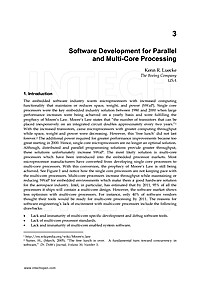
Software Development for Parallel and Multi-Core Processing
The embedded software industry wants microprocessors with increased computing functionality that maintains or reduces space, weight, and power (SWaP). Single core processors were the key embedded industry solution between 1980 and 2000 when large performance increases were being achieved on a yearly basis and were fulfilling the prophecy of Moore's Law. Moore's Law states that "the number of transistors that can be placed inexpensively on an integrated circuit doubles approximately every two years." With the increased transistors, came microprocessors with greater computing throughput while space, weight and power were decreasing. However, this 'free lunch' did not last forever. The additional power required for greater performance improvements became too great starting in 2000. Hence, single core microprocessors are no longer an optimal solution.
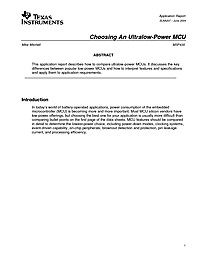
Choosing An Ultralow-Power MCU
This application report describes how to compare ultralow-power MCUs. It discusses the key differences between popular low-power MCUs and how to interpret features and specifications and apply them to application requirements
Arduino Programming Notebook
This notebook serves as a convenient, easy to use programming reference for the command structure and basic syntax of the Arduino microcontroller. To keep it simple, certain exclusions were made that make this a beginner’s reference best used as a secondary source alongside other websites, books, workshops, or classes. This decision has lead to a slight emphasis on using the Arduino for standalone purposes and, for example, excludes the more complex uses of arrays or advanced forms of serial communication.

Lessons in Electric Circuits - Volume III - Semiconductor
This book covers all of the common semiconductor devices and their principles of operation. However, the true value of this reference is in the fact that it provides key circuits and applications where they come in handy. A few of the devices that are covered in this book are Bipolar junction transistors, diodes, JFETs, thyristors, OPAMPs and FETs. This book will be a good reference in your library that has a clear style of explanation.

Introduction to Embedded Systems
This is the first chapter in the book Embedded Systems Hardware for Software Engineers.

Embedded Touchscreen Handbook
I want to add a touchscreen to my embedded product. Where do I start? That question is common nowadays. Most manufacturing companies are seeing the value – maybe the necessity – of touch screen technology. Many of them don’t have a long-term or close association with the technology, yet they expect their embedded engineers to handle the project successfully and on a tight schedule. These engineers often have questions... - How much am I going to have to learn to get the job done? - I’ve heard that LCD suppliers were not like other suppliers. But, how so? - What don’t I know that could shift the project from “exciting” to “doomed.” You have choices: Probably the three major questions that crop up when you need to add an LCD touch screen to your product are these: - Should I use a full-blown, embedded operating system, like Windows CE, CE Linux or QNX? - How much work does it take to develop an in-house LCD system from scratch? - Do I have other options? The answer to the first two questions is a resounding “maybe,” (depending on what you need to accomplish). The answer to the third question is, probably “yes.” In most cases, there is another option. Who should read this? If you are an embedded engineer who is thinking of adding a touch screen to your product, and if: - You need to know what is involved in adding color touch controls to your product. -You need to understand the risks (both known and hidden) involved in LCD technology. - Your main area of expertise is not LCD technology. - You don’t want to re-focus your time to acquire color LCD technology expertise. If you find that any of the statements above voice your concerns, you may find this paper worth reading.




















